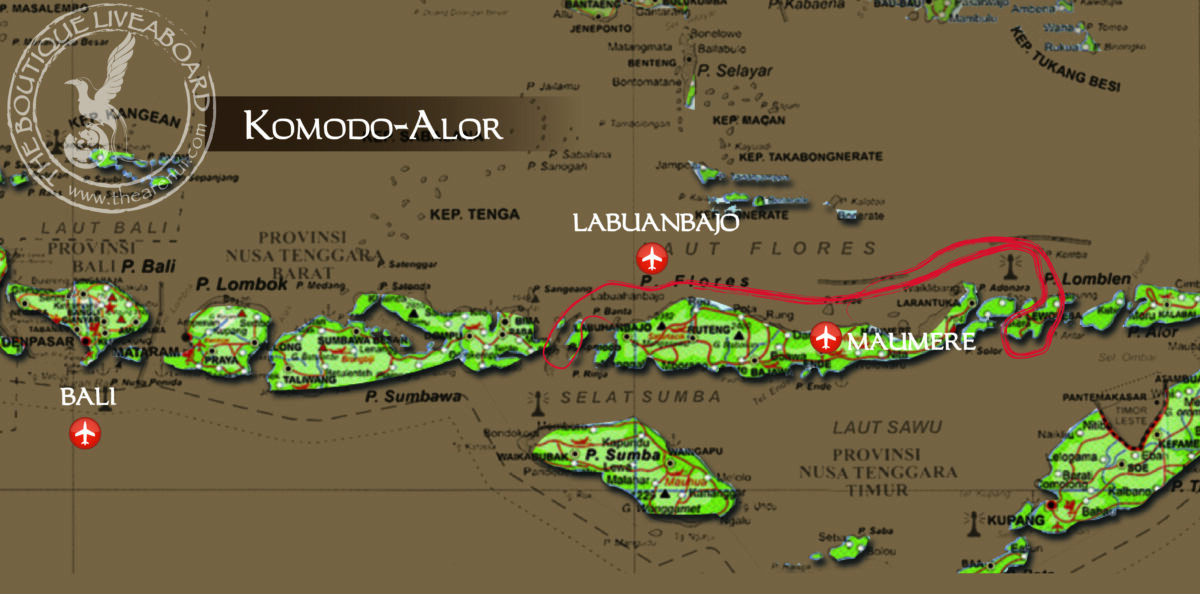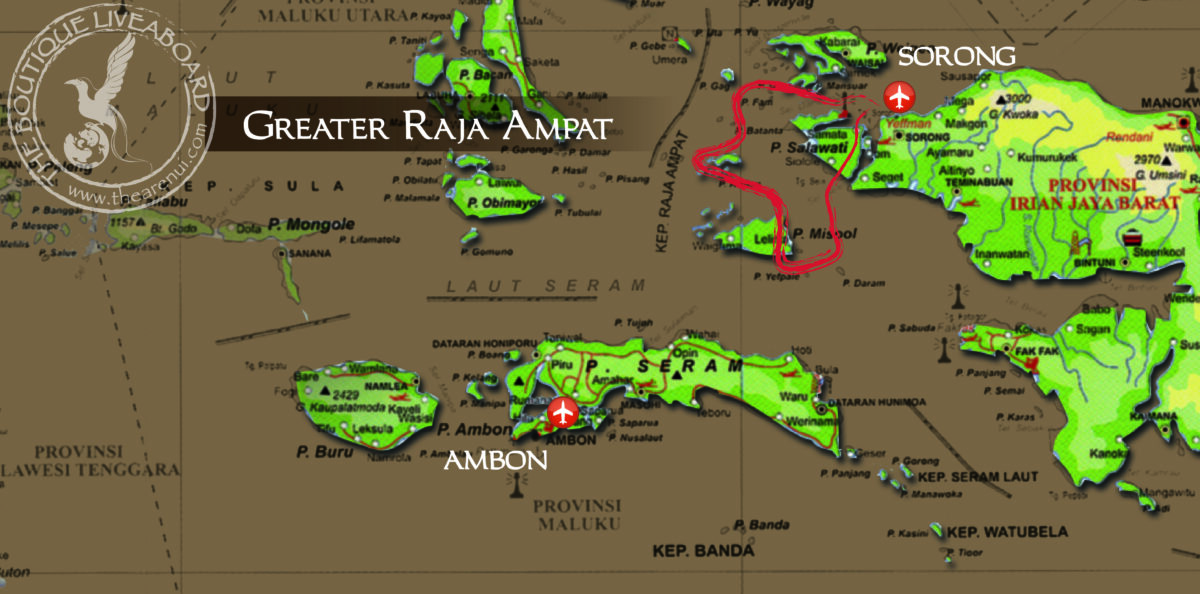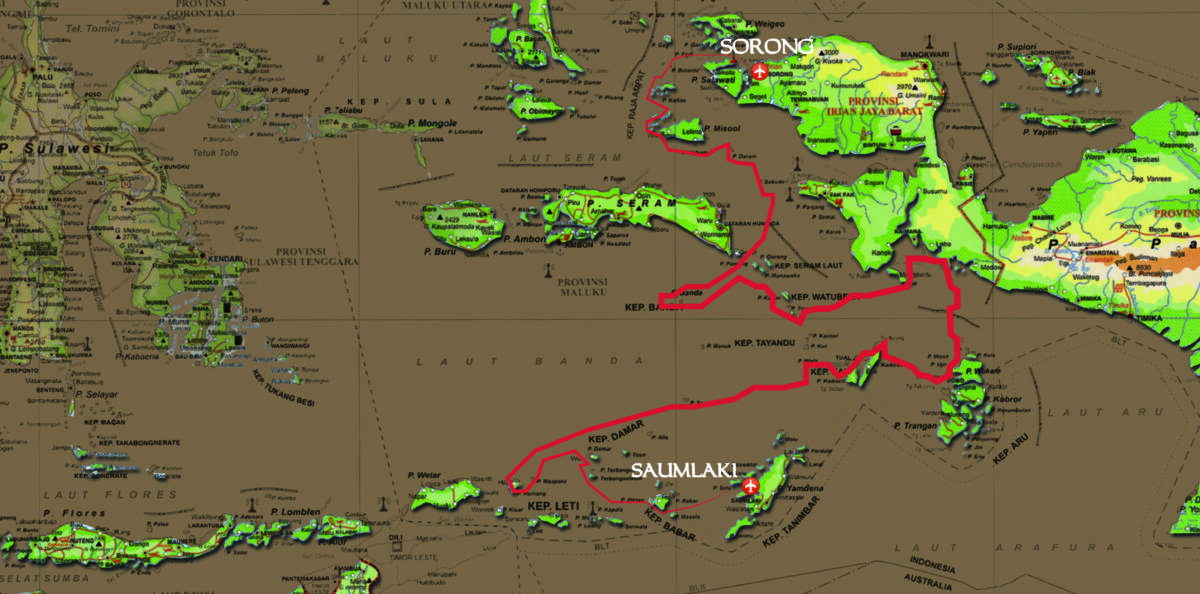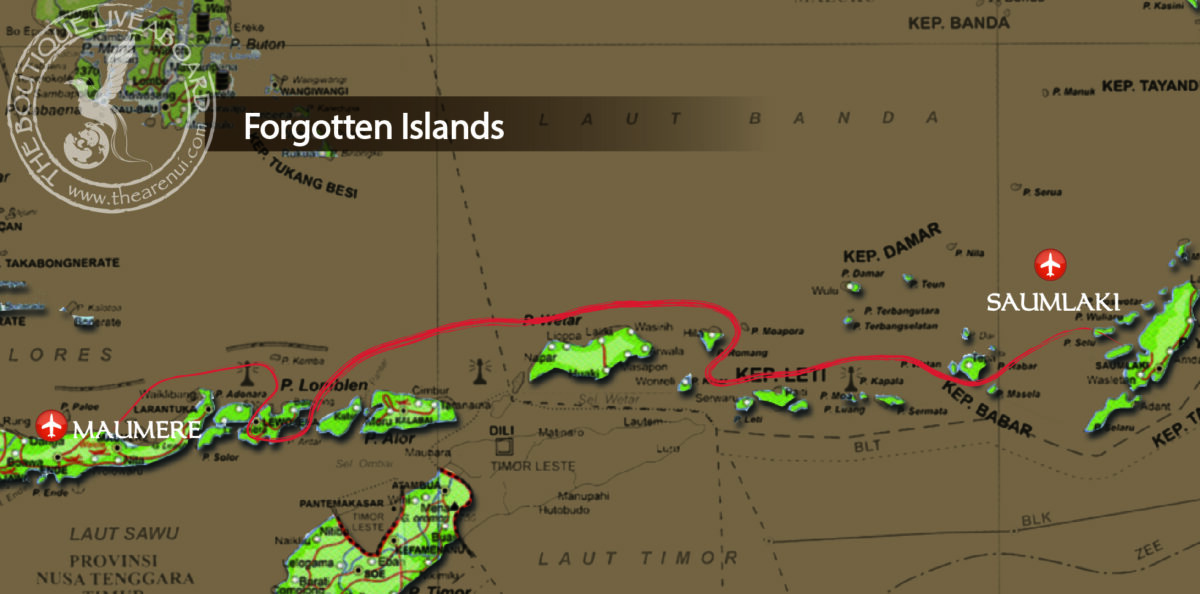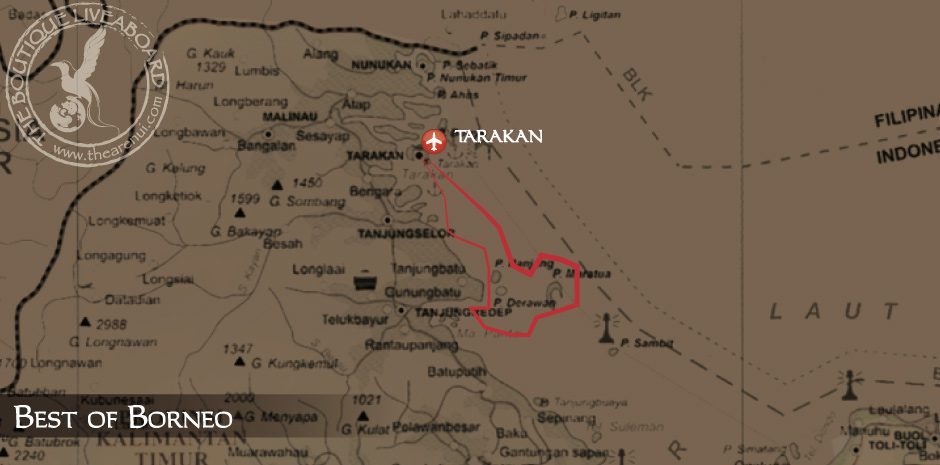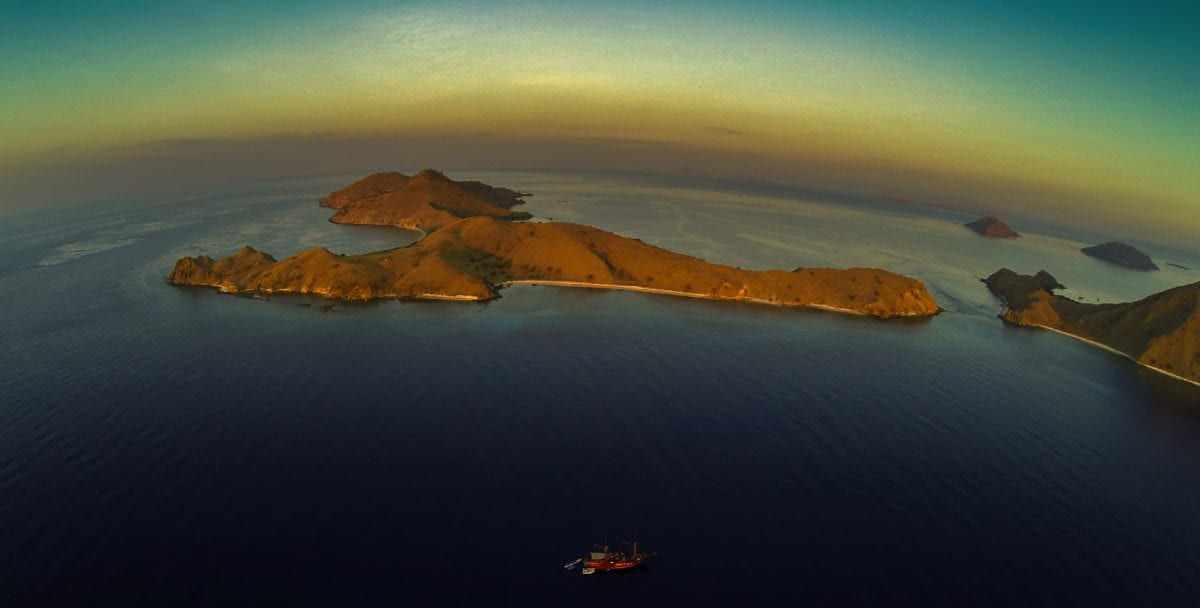Archives: Cruise Schedule
GREATER RAJA AMPAT 03 Dec-16 Dec 2030
GREATER RAJA AMPAT
14 Days/13 Nights Sorong – Sorong Cruise Itinerary
Day 1 Embarkation in Sorong
Raja Ampat means ‘Four Kings’. In an archipelago of over 1,500 small islands there are four main islands or ‘kings’– Waigeo, Salawati, Batanta, Misool. The majority of Raja Ampat is in Marine Protected Areas. These islands usually experience varying visibility depending on the weather conditions and warm water around 27-30C (81-86F).
Days 2-9 Misool, Raja Ampat (29 dives)
Misool is in the south of Raja Ampat and we will dive at the many small islands in the southeast. Over the past years Misool has become Raja Ampats best diving area, being famous for the profusion of colorful soft corals, sea fans beautifully draped all over the reefs and a huge amount of all kind of fishes on every single dive. Take a look at some photos taken in this area in our album Soft Coral Heaven.
The islands in southeast Misool are grouped by areas. Here are the names of the areas and dive sites we may visit (weather permitting):
Misool – Boo Area
Boo Windows is the famous dive site in this area. It is best known for the “windows” or rounded openings on the end of the largest rock that completely pierce the reef from the surface down to about five meters/fifteen feet. Although the two rocks appear separate from the surface they are in fact connected underwater by a magnificent reef draped in soft corals and brimming with fish. See photos of the Windows here. Boo Ridge is an underwater ridge coming off the eastern point of Boo Island. Both sides are covered in huge gorgonian sea fans. At these dive sites look out for turtles, reef sharks, pygmies, nudis and schooling batfish, fusiliers and snappers. Shadow Reef is a submerged seamount south of Boo.
The fish life here is profuse with napoleon wrasses of all sizes, baby white tip reef sharks sleeping under the table corals, schooling barracuda and batfish and for the lucky ones maybe a manta ray circling the cleaning stations. Birthday Cake is a beautiful ridge in the Boo Area. Look for pygmy seahorses, flatworms and nudibranch in the deeper section and beautiful soft corals in the shallows, where we even have seen the famous “walking shark” – epaulette shark. Eagle Nest is a seamount close to the island of Warakaraket. With the right current we have been lucky to see lots of fish action, including grey reef sharks, giant travellies hunting in clouds of fusiliers and even manta rays.
Misool – Yuliet Area
The tiny islands of Yuliet and Romeo both have surrounding plateaux in the shallows that slope down to reefs or small walls. At Yuliet there is a good chance to see the ‘Santa Claus pygmy’ a red colour variation of the Denise pygmy seahorse. In the shallows are large coral heads completely covered in colourful soft corals. Schools of barracuda and batfish as well as napoleon wrasses are often seen here. Romeo is a great night dive where we will look for the endemic epaulette shark, the ‘walking’ shark.
Misool – Fiabecet
Fiabecet area has a selection of dives where the colourful soft corals and beautiful sea fans literally smother the reefs. The soft corals here are truly outstanding. There is a deep underwater ridge connecting the island of Boo in the east to the island of Kalig in the west. In parts this ridge moves up shallower and forms the dive sites of Boo West Corner, Batu Kecil (aka Tank Rock), Nudi Rock, Whale Rock and Kalig Ridge.
Expect healthy fish life, pygmy seahorses galore, nudis, colourful anemones, reef sharks and perhaps a Wobbegong shark. Anti-chovy is a large underwater seamount with some deep pinnacles covered in stunning corals. Mobula rays, golden trevallies and Napoleon wrasses can be found here. On top of the seamount look for turtles, stonefish and reef octopus.
Misool – Wayilbatan Area
Neptune Fan Sea is a small channel between two islands with a shallow wall completely covered in some of the biggest gorgonian sea fans you will ever see. At the start of the dive explore the beautiful coral heads where huge groupers can be hiding. Then drift along the wall and enjoy the view of the sea fans, stopping once in a while to find the tiny pygmy seahorse. Four Kings is a stunning dive site made up of four underwater pinnacles. Swim from one rock to the next enjoying the soft corals and fish life. Look out for schooling big eye jacks, spadefishes and grey reef sharks. Wedding Cake, Dunia Kecil and Wayili Rock offer chances to see schools of batfish, trevallies, barracuda, pygmy seahorses and reef octopus.
Misool – Daram Area
Daram is the most easterly point of the islands we might visit in Misool. The reef at Andiamo is stunning and is large enough for at least two dives. There is a submerged pinnacle where sea fans are surrounded by schools of fusiliers and batfish. A short swim across a sandy bottom brings you to the main reef lush with soft corals. In between the two islets is a gap thick with sea fans and is excellent for wide-angle photography.
Look out for black tip reef sharks and Napoleon wrasse, if you can see them through all the fish! Candy Store is so named because the first divers to explore this reef felt like kids in a candy store. Huge sponges, beautiful soft corals and sea fans cover this dive site, especially in the valleys where schools of fusiliers, butterfly fish and sometimes barracuda gather. Warna Berwarna in Bahasa Indonesia means “Vibrant Colors”. Expect to see sea fans in all possible colors and watch out for pygmy seahorses. On the north western side of the island there is a beautiful ridge coming out where tons of fusiliers and orange spotted trevallies hang out in the blue. The shallows are covered with healthy hard corals and often we get to see schooling bumphead parrotfishes.
Misool – Pele Area
Kaleidoscope is so called because of the profusion of colours produced by the huge soft corals draping the shallow rocks and coral heads. A ridge extends out west from the island which can full of fish when the current is running. Back at the island finish the dive under the overhangs.
Misool – Sagof
The little islets of Baby Rock and Two Tree Island create amazing dive sites with abundant fish life. There is a resident school of batfish at Baby Rock and Two Tree Island is often full of thousands bait fish. The Watch Towers is a massive seamount with tons of black coral in the deeper section. Schools of yellow snappers, barracudas and giant trevallies can be found in the up-current side. On the hard coral plateau look out for Wobbegong sharks and crocodile fish.
Misool – Tomolol Cave
There is a possibility on this day to visit Tomolol Cave that has a river-sized waterway running through it. We take a 20-minute tender ride through a pearl farm and into the rugged interior. Once at the cave we float and paddle our way inside to enjoy the amazing rock formations. There is a large opening at the other end and also a ‘secret’ cave to explore. This tour is dependent on receiving permission from the pearl farm and local village. Check our Tomolol Cave photo album.
Day 10 Batanta Island (4 dives)
Batanta Island is the only black sand dive we will be doing during this trip. Here we will be doing some creature hunts from mantis srhimps to the elusive Rhinopias or one of our favorite to look for is the juvenile Wobbegong, the size of the palm of your hand makes it one of the most rarest creature on the site. Black Beauty is a place where we will spent all day diving in the same site but every dive is completely different, the sandy slope is also covered with algae which is the perfect place for creatures to hide, such as ghost pipe fish and frog fish. Different octopus like the wunderpus or the algae octopus have been seen here.
Day 11 Penemu Area (3 dives)
Penemu is an island west of Waigeo with a selection of dives sites. Melissa’s Garden is the most well known. Here there are very healthy hard coral reefs in the shallows and a beautiful coral garden sloping to the sides where schooling fish hang out in the current. Wobbegong sharks like to sleep under the coral heads and inside the large cup corals here. Hundreds of anthias dance in and out of the corals where you might also see a sea snake.
Penemu Wall and My Reef are also great dives in this area. After the two morning dives we will visit the viewpoint in Penemu where you can appreciate the iconic Raja Ampat view of the groups of islands nestled inside beautiful blue lagoons. Check out our Beaches & Islands album. At sunset we will dive at Batu Rufus. There is a shallow swim through framed beautifully by soft corals and sea fans. Below this is a sloping reef where hard corals shelter cardinal fish in the shallows and in the deep, Pontohi seahorses and nudibranch can be found on the coral heads.
Days 12-13 Dampier Strait (5-6 dives)
The strait that flows between Waigeo and Batanta is rapidly becoming known as having really good diving in Raja Ampat as a result of the nutrient-rich ocean currents passing through. Everything that makes for a wonderful dive can be found here. But even beyond the usual delights and the satisfaction of spotting prized macro subjects such as the newly discovered Pontohi pygmy seahorse on the coral heads, there are surprises to be found in every dive.
The fish life in this area is as plentiful as can be expected at sites with a great deal of healthy hard and soft coral. Wobbegong sharks can also be found at any of these dive sites, especially at Mioskon. Cape Kri holds the impressive record of 374 fish species identified during one 90-minute dive. Blue Magic is a submerged seamount where there is a chance to encounter Giant manta rays.
Ironically, sardines are about the only reef fish not found at the site of Sardine Reef, but you won’t even notice as you see swarms of fusiliers, surgeonfish, trevallies, rainbow runners, sweetlips and bannerfish practically blocking out the sky swarming over a reef decorated with sea fans, soft corals and huge orange elephant ear sponges encrusted with pastel colonies of tunicates. One of the more unique thrills of this site is being able to hear “fish thunder” – the loud booming sound made when a large number of fish move rapidly through open water.
There is also a small village with Sawandarek Jetty. In the shallows the jetty posts are covered in soft corals and below look for sweetlips, big eyed jacks and massive green turtles. On the reef see huge giant clams nestled among pulsing soft corals. At night look for huge lobsters and maybe even catch a glimpse of the endemic epaulette shark, the ‘walking’ shark. The reef also provides shelter for many interesting small animals like hermit crabs, flatworms and the very cute pughead pipefish.
Between the dives there is an opportunity to visit the village on Sawandarek Island to see the traditional way of life for these island people. Be ready to be greeted by many children who are more than willing to pose for photographs. Anyone joining our cruise is more than welcome to bring along some goodies for the children at Sawandarek. Obviously the children love sweets but we encourage people to bring pencils, pens, notebooks or coloring books – all of which don’t rot their teeth! The school always needs more materials and the girls love hair clips and bands. Please try to limit the amount of plastic packaging, leave this at home where it can be correctly recycled.
An optional tour in the Dampier Strait area is a hike in the jungle to see Birds of Paradise. There will be an extra charge for this tour and it is dependent on the weather and all of the guest’s preferences.
On the last full day of the cruise there will be one or two dives depending on the flight times out of Sorong the next day. After the dives we will travel back to Sorong.
Day 14 Disembarkation in Sorong
Total dives: 41-42 dives
BEST OF INDONESIA 09 Oct-29 Oct 2030
FORGOTTEN ISLANDS & ALOR 19 Apr-30 Apr 2025
FORGOTTEN ISLANDS & ALOR
12 Days/11 Nights Saumlaki – Maumere Cruise Itinerary
Day 1 Embarkation in Saumlaki
Days 2-8 Forgotten Islands
The Forgotten Islands are part of a remote archipelago in the southeast corner of the Moluccas (Maluku Tenggara). Despite the remote feeling in other parts of Indonesia (such as Alor or Banda), the Forgotten Islands are isolated even by Indonesian standards, covering a 1,000 km long chain of islands staring at Timor and extending up to West Papua. The Tanimbar group of around 65 islands that separate the Banda Sea from the Arafura Sea include the island of Yamdena where the capital Saumlaki is where this cruise begins.
There are many groups of islands in this area and the Forgotten Islands are relatively undiscovered and still being explored. The exact itinerary around these islands will depend exclusively on the weather and current conditions. Also due to the big distances between island groups some of the days will include three day dives before heading off in the afternoon and travelling overnight. When the next location is closer and there are anchorage spots in sheltered bays we will offer a fourth dive, usually a night dive.
Dive sites in the Forgotten Islands are characterised by endless reefs and spectacular deep walls covered in soft corals, sea fans and huge sponges. These islands usually experiences amazing visibility and warm water around 27-30C (81-86F). Here are the names of the islands we may visit (weather permitting) during your cruise:
Dawera Island (4 dives)
This small island is in the northern part of the Babar group of islands. There is a seamount where the reef is untouched and so full of fish you won’t know where to look! Along the north side of the islands there are numerous wonderful dive sites ranging from Tanjung Raja where there are stunning soft corals to Sponge Delight where there is a huge resident school of barracudas and even a chance to see hammerhead sharks. The diving in this area is so good we may even stay an extra day.
Dai Island (3-4 dives)
The villagers on this island still practice traditional hunting with bow and arrow. Steep slopes provide hunting grounds for schooling barracuda and trevally. Large sea fans on the reef are surrounded by very healthy reef fish life. The shallows here are full of hard corals decorated with anthias.
Serua/Teun/Nila/Nil Desperandum
Teun, Nila and Serua, often referred to as TNS, are all small, very remote volcanic islands only accessible by liveaboard, located just east of Damar. You will feel as if you have reached the ends of the earth and that may be why there is a growing interest in diving in this zone. Although the sites here remain relatively unexplored, experiences so far have revealed tremendous diving potential and splendid coral reefs.
Close to the small island of Nila are two atolls Dusborgh and Nil Desperandum. Weather permitting we will spend two days in this area, making a small bay on the east side of the island of Nila our base. There is also a night dive opportunity here.
Nila/Dusborgh (3-4 dives)
Dusborgh is a submerged atoll with a surrounding reef that reaches all the way up to the surface. The reef then slopes steeply to deep walls. As with all of the Forgotten Islands the walls are covered in huge sponges and sea fans. With the amazing visibility keep an eye into the deep for passing pelagics. A small bay on the east side of the island of Nila has a night dive opportunity.
Nil Desperandum (3-4 dives)
Nil Desperandum means “don’t despair” possibly referring to a ship wrecked here centuries ago. It is a big atoll with very deep drop offs. Schooling sharks have been spotted in the deep here with a chance to see hammerhead, silky and grey reef sharks.
Pulau Damar/Nusleur/Terbang (4 dives)
Close to the big island of Damar the small islands of Nusleur, Terbang Utara and Terbang Selatan are surrounded by pristine beaches that stretch out to coral reefs that then drop down to the most beautiful, untouched walls. From top to bottom, the reef is an explosion of different colours and forms and seems to be in constant motion from the swarms of fish darting about. You may find yourself floating in the midst of a huge school of fish as the sea creatures here appear quite curious, perhaps because they are generally not used to seeing many divers. Another unique attraction in this area is the wall of sulphur formed as a result of its proximity to the volcano on Damar. There is a possibility to visit a village on Damar where there is also a black sand night dive.
Nyata (4 dives)
Tanjung Nyata is a wall covered in huge sponges that then turns into a deep, steep slope. On the way look out for passing large fish like tuna and trevallies. At the top of the wall is a very healthy hard coral reef where there is a resident school of snappers. At the start of the slope is a deep pinnacle where grey reef sharks circle and on the slope itself are again huge sponges and schooling fish such as barracuda, surgeon fish and fusiliers. Thousands of blue tooth triggers and pyramid butterfly fish hang out. We have even seen eagle rays pass by.
Pulau Wetar/Reong (3 dives)
Not many people can say that they have dived Wetar Island. It has several calm bays where interesting critters can be found as well as swift drift dives between Wetar and Reong that takes you past a spectacularly coloured wall.
The small island of Reong, which lies off the northwest coast of Wetar, presents a change in scenery as it is made of limestone. Reef sharks, barracuda and trevallies frequently visit these waters. Other delights can be found while diving the impressive walls and a site full of diverse marine life.
Tanjung Nunukae on Wetar Island is generally characterised by shallows forming a plateau that narrows as it goes deeper until it drops off abruptly, forming a very nice wall swathed in gigantic sea fans, cup corals and impressive sponges. Divers have come across both mobula and manta rays here. Currents are generally moderate to strong.
Day 9 Pura Island/Kalabahi Bay (4 dives)
Dives in the Alor/Pantar Strait promise a variety of thrills as the sites present a wide array of exciting possibilities, with topography ranging from dramatic shear drop-offs, spurs jutting out from the shore mingling together with shallow reefs where the light brings out the full colour of the dazzling corals covering all surfaces. The water temperature can be a little cooler in this area dropping from the normal 28/29 degrees Celsius (82-84 Fahrenheit) to a possible 20 Celsius (68 Fahrenheit).
Here you can see the famous Pura Island villagers splash out of their wooden dugout canoes diving underwater with homemade goggles made out of wood and the ends of glass bottles.
During the day we will also look out for large pelagics who use the Pantar Strait as a thoroughfare. If there are any sightings of whales, dolphins or even Mola Mola we may forego a dive and head out in the tenders with snorkelling gear to see if we can have a lucky encounter.
Yan Village
At Yan Village there are several wonderful spots to dive. Walls covered in sponges topped with shallow hard coral reefs where you can spot the elusive Mandarin fish to black sandy slopes where fans of macro will get their fill too. Some examples of the critters here are frogfish, weedy scorpionfish, all sorts of nudibranchs and yellow, blue and black ribbon eels.
Clown Valley
One exceptional dive site on Pura Island is probably the only place in the world where you will see this phenomenon. The entire reef is completely covered in anemones of all shapes and sizes. Enjoy a drift dive along this site and enjoy the abundant fish life, with thousands of colourful anthias and damsels dancing off the reef. Take a look at photos of Clown Valley and other wide-angle opportunities in Alor here.
Kalabahi Bay
Mucky Mosque and Rocky Church are two of the great muck dives we will do inside Kalabahi Bay on Alor Island. The ‘holy grail of fish’ Rhinopias can be found here, with a chance to see both the weedy and paddleflap scorpionfish. Ghost pipefish, soft coral crabs, frogfish, various octopus including the wunderpus and mimic, snake eels, sea moths, sand divers and many other remarkable creatures The only way you are likely to see stranger ones is if you do a night dive here when unimaginable ones begin foraging out of their holes.
Day 10 Visit traditional Abui tribe village/Reta Island (2 dives)
In the morning we will visit Takpala or Latevui village, both villages still living by their old Abui traditions. The villagers will perform the Lego-Lego dance wearing traditional clothing with brass anklets that make a wonderful jingling sound as they perform. Afterwards there is an opportunity to purchase handmade ikat, woven fabrics of various colours and motifs, as well as jewellery and wooden artifacts. Take a look at our photo album of these villages at Alor Abui Tribe
After the village tour we will travel out into the Alor/Pantar Strait to Reta Island where we will do two dives.
Reta Island
Reta Island has beautiful vertical walls with overhangs, undercuts and a deep plateau at 25m/75ft. It is full of hard and soft corals, barrel sponges and whip corals. At the top of the wall is a gorgeous coral garden teeming with reef fish.
Day 11 Kawula Island (4 dives)
Next to the north of Kawula Island there is a beautiful, calm bay overlooked by Lewotolo volcano. We spend the day diving here.
Tanjung Bacatan
Tanjung Bacatan is within view of Lembata and Komba volcanoes. Tanjung means corner and the dive site is situated on a point on the north shore of Kawula island. The dive site consists of a wall covered in crevices and ledges covered in soft corals and large sponges with hard coral gardens in the shallows. At one end the wall turns into a white sandy slope hosting many varieties of reef fish and triggerfish. A resident school of barracuda can be seen here as well as turtles and maybe even large trevallies passing by.
Takat Prau
In the middle of the bay there is a seamount we call Takat Prau. There is a small wooden fishing boat wrecked in the deep right next to a sea fan with pygmies. There can be schooling fusiliers here with small reef sharks patrolling the pinnacle. Leaf fish make their home in the shallows and large reef octopus are often spotted hunting in the hard coral.
Padang Pasir
This dive site has two sections. A huge expanse of white sand extends to the south and a mini wall and reef comes out from the corner of the island. In the sandy area look for waspfish, flounders, stingrays and ghost pipefish. On the wall algae shrimp, moray eels, lionfish and beautiful angelfish hide out. At the top of the reef there are healthy staghorn corals where you might spot a mandarin fish. At night the wall and reef come alive with shrimps and crabs and there is a chance you will see Spanish dancer nudis. Or hunt around in the sand for stargazers, bobtail squid and frogfish.
